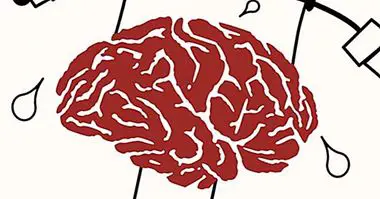The 7 most common specific phobias
Specific phobias are a fairly common clinical picture in psychology consultations. We all know someone who feels horror when they see a spider in the distance, even if it measures less than two centimeters.
He panics as he climbs the steps of a spiral staircase. That turns pale when you see an airplane taking off, even if it's in a movie or you climb seven floors on foot in order not to take an elevator, when we are not ourselves affected.
Next we will see which are the most common specific phobias and what are their characteristics.
What are specific phobias?
Specific phobias are those in which the element that produces strong fear or fear can be located and isolated from the rest in a relatively simple way.
Within anxiety disorders, specific phobias are the most frequent in the general population, with an estimated prevalence of 10%.
In phobias there is an intense and persistent fear, excessive or irrational beforeobjects or concrete situations (animals, heights, closed spaces, etc). Physical proximity or anticipation of the object or situation feared causes an immediate response of anxiety (sweating, tachycardia, palpitations, tremors, dizziness, etc.) that can lead to panic attack, so the person will try to avoid those objects or situations in the future . To be able to diagnose a phobia, it must produce a great interference or high degree of discomfort in the life of the subject.
- Related article: "Types of phobias: exploring the disorders of fear"
Most common specific phobias
Below you can see a compilation of the most widespread specific phobias, with a basic description of each one.
1. Phobia to heights or acrophobia
Acrophobia is an intense and irrational fear of heights, even when there is no risk. People who are afraid of heights are very anxious when approaching a lookout, or precipice, climbing a high floor, crossing bridges, or even staying in high places in cinemas, theaters or stadiums.
Many patients with phobia of heights they fear the sensations they experience in the heights , such as unstable balance, sweating or dizziness. The feeling of panic can be disproportionate even with little height. It is estimated that between 3 and 5% of the population suffers fear of heights, being one of the most common phobias.
- Maybe you're interested: "Acrophobia (fear of heights): what is it and how to overcome it?"
2. Fear of flying or aerophobia
Aerophobia is the irrational and excessive fear of traveling by plane. The fear of flying is related to having an accident, perceive instability in the plane , to think about not being able to escape in mid-flight, to feel that one does not have control of the situation or to suffer feelings of panic during the flight.
Although it seems that more than 90% of passengers travel with fears of some kind, people suffering from this phobia, approximately 3%, not only experience a slight concern at the time of landing and takeoff, but intense anxiety and excessive that prevent them from planning, or imagine a future trip by plane, even months before carrying it out.
3. Claustrophobia
This disorder involves the excessive fear of being in small spaces . It is estimated that between 2 and 4% of the population suffers from this phobia. Breathing difficulties and fear of suffocation, along with the fear of not being able to move or escape, are typical phenomena in claustrophobia. These people tend to avoid elevators, tunnels, the subway, small or windowless rooms, telephone booths, closing the door or bolt in a bathroom, etc.
4. Animal phobia (zoophobia)
Fear of some animals (spiders, dogs, birds, snakes, cats) have their origin in ancestral fears that have allowed our ancestors to survive . The phobia of animals is another of the most common, affecting between 3 and 5% of the population. Among the fears of animals (zoophobia), the most frequent are arachnophobia (fear of spiders), ophidophobia (fear of snakes), cynophobia (fear of dogs), ornithophobia (fear of birds) or ailurophobia ( fear of cats).
It is common for people with this phobia to fear the physical appearance and movements of the feared animals. In the case of small animals (insects, spiders, rats) there is both a reaction of fear and a feeling of disgust or disgust. Interestingly, many affected do not believe that the animal will hurt them, but think that they will experience unpleasant sensations, lose control, or hurt themselves while trying to escape.
5. Blood phobia, injections or wounds (SIH)
Approximately 2-3% of the population has a blood phobia, injections or wounds (SIH).People who have this type of phobia, usually avoid all situations where they anticipate that they will see or be in contact with blood, as in blood draws. Most phobic to blood (hematophobia) They also have phobia of injections, although only a minority of them have a blood phobia.
Unlike the other phobias, the pattern of anxiety response is very different. A response occurs in two phases, in which at first, and in the presence of needles, blood or wounds appears a rapid increase in anxiety (palpitations, increased frequency and intensity of breathing, muscle tension, sweating) and later, in a second phase, a rapid drop in blood pressure and heart rate, which causes dizziness and can lead to fainting.
- Maybe you're interested: "Blood phobia: everything there is to know about hematophobia"
6. Brontofobia
the brontofobia is the fear of atmospheric phenomena such as thunder, lightning and storms . Approximately 2% present this phobia. It usually begins in childhood and can continue into adult life. When the lightning appears or the sound of thunder is heard, the anxiety begins to increase in the affected person.
The main fear is to suffer damage or be struck by lightning, although it is also possible that other fears appear, such as losing control of the situation, becoming unconscious or suffering a heart attack because of the anxiety experienced.
7. Dentophobia or dental phobia
Dental phobia, consists of a extreme, unjustified and persistent fear of the dentist . Between 2 and 3% of the population suffers from this phobia, where it is very common that just the mere thought of going to the dentist causes high anxiety, even weeks before the appointment.
Bibliographic references:
- Bados, A. (2009). Specific phobias: Nature, evaluation and treatment. Electronic publication



















